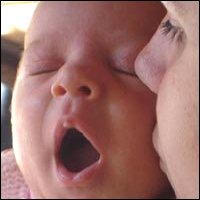
Easing Separation Anxiety in Children: Meet Your Child with Full Acceptance and Deep Connection
Good News for You: Separation Anxiety in Children Is a Normal Phase of Mental and Emotional Development!
Separation anxiety in kids may feel overwhelming for both child and parents.
Perhaps you also feel worried that your child's separation anxiety is an indication that something is 'wrong'!
Well, most likely you can relax in that specific worry department!
Most likely, nothing is wrong with your child or with what you're doing!
You see, separation anxiety in children is a completely normal phase in the developmental sequence of infants and usually emerges in conjunction with the understanding and acquisition of the skill of object permanence.
Although the duration and intensity of separation anxiety may vary from child to child, there's no need to be alarmed - separation anxiety is a good and healthy sign.
If your child is going through a patch of baby separation anxiety, it tells you that:
- Your child's intellectual and mental skills are developing and maturing as the first seed of abstract thought is being planted (I will get more into that in a bit).
- Your child's relation and emotional attachment to you as a parent is strong and healthy.
What Is Separation Anxiety in Children?
Newborns are normally quite adaptable. As long as their physical needs are being met (and they are not hungry, tired, bothered by colic etc.), most babies adjust easily to new people and are rarely bothered or distressed by a change in caregivers.Around 4-7 months of age, they will be slowly beginning to develop object permanence; the realization that people and things do not cease to exist just because they are out of sight.
This means that when you leave, they know that you have disappeared. However, they are unsure when - or if at all - you are coming back.
Obviously this is very scary!
Imagine not knowing if you'll ever see Mom or Dad again. And there's nothing at all you can do about it! You can just cry and cling and express your need for Mom's or Dad's return.
The onset of separation anxiety in children may mean that normally 'easy' children all of a sudden start displaying episodes of crying, tantrums, and clinginess.
According to the terminology of developmental psychology, these emotional and physical attempts to make you stay are called expressions of attachment behavior.
Attachment behavior may be both puzzling and frustrating to a parent who does not know that this is actually a healthy reaction to separation.
As your child is perceiving the world in an ever expanding way, it may appear very intimidating and confusing. This is only logical. The world is big, in many ways incomprehensible and as a baby you have no control over it.
But a safe place does exist and that's with you. You are Home. You are the safe haven that makes your child feel whole and secure.
So, no wonder you child wants to stay with you all the time where ever you go!
 Separation anxiety in children is said to be generally strongest between the ages of 7-18 months, although it can subside and reappear several times until age four.
Separation anxiety in children is said to be generally strongest between the ages of 7-18 months, although it can subside and reappear several times until age four.
However, as mentioned, the degree of separation anxiety in children varies a lot.
Some experience very little separation anxiety while others become very distressed and require more time and attention to make adjustments (for instance my own high need baby son's baby separation anxiety started full throttle only after a few months).
The Two Main Strategies for Supporting Your Child Through Separation Anxiety
There are many different philosophical avenues of advice made to help parents ease separation anxiety in children.In my experience the two most dominant philosophies are these:
1) The Acceptance Strategy
This strategy aims at reducing separation periods to a minimum for a long as the separation phase is at its highest.
2) The Training Strategy
This strategy focuses on slowly 'training' independence by gradually introducing situations of separation.
Here's my own opinion on these strategies of dealing with separation anxiety in children. My choice of primary and secondary strategy reflects my own experience with my son!
Aim for the Acceptance Strategy for as long and as much as possible. In my view this strategy is optimal as it aims at consistently meeting your child's need for basic security.
According to attachment parenting expert Dr. Sears, the more, the deeper and the quicker you meet your child's needs, the more you lay the solid foundation for healthy independence later.
But if you have to periodically leave your child - which many of us do, when we have to go back to work - working with the training strategy might be a good help.
In the following sections you may find more in-depth advice and tools to help you if you have to leave your child when he or she is experiencing separation anxiety.
Gently Introduce Limited Periods of Separation
Introduce new people and settings gradually, or visit a caregiver or day care center a few times together before actually leaving your child there so he or she has an opportunity to explore a new environment from the safety of your presence.
Remember, where ever you are, you = Home!
In other words, stay with your child the first couple of times in day care or with the babysitter after which you begin leaving your child for brief periods of time.
If your child is not an infant, you might prepare your child by reading books about new and exciting things or allowing them to participate in packing the backpack, choosing toys to take to the babysitter, or selecting snacks.
Letting them make decisions may help them gain a sense of control of their own life which facilitates the creation of the important sense of security.
Develop Rituals:
Providing Security via Predicability

As with the concept of object permanence, a secure, dependable, and predictable routine may help your child work through separation anxiety.
Little ones feel safe within routines and patterns because they know what to expect.
In a world where very little is up to them, they get a sense of control by knowing what will happen.
If you develop a goodbye ritual – a hug, a kiss, a song, a wave from the car window – your child will begin to associate that action with your eventual return.
Rituals can create security and safety because they begin to learn the concept of 'cause and effect' which is also vital for independent thinking and decision making.
Introduce Separation Soother; a Lovey

Allow your child to take something familiar (like a teddy bear, a pillow or doll) with him or her when he goes to a babysitter's or day care center.
This familiar item will help soothe your child in a not so familiar environment.
If the babysitter comes to your home, consider letting the child keep something of yours, such as a scarf, book, or other special item, so that he or she may feel connected to you even when you are gone.
Remain Consistent in Your Goodbye Patterns

Let your child know that she will be alright, but even as tempting as it might be, try not to give in.
By prolonging your departure, continually coming back to check on her, or cancelling your plans, you are sending your child the message that crying, clinging, or tantrums will avoid separation.
This would be okay if you could avoid separation, but if you can't your child might be confused as he or she wouldn't know when to expect what.
Try to keep up the good spirit and tell your child that you are leaving and then go with a quick, undramatic departure.
Eventually (even though it may take quite a while), your child will realize that you always return.
Show Understanding of Your Child's Feelings
Show understanding and acceptance by letting your child know that you appreciate their feelings.
As parents, we already have an understanding of all these concepts that our children are still trying to grasp, so it may be easy for us to trivialize or minimize the situation.
By telling our child to 'stop being silly' or threatening punishment, we are actually communicating that what our child is experiencing is invalid.
In essence, a parent that does this is actually teaching a child to push aside or ignore his feelings and responses and to behave in a socially acceptable manner – or at least in a manner acceptable to the parent or caregiver.
In this way, a child may learn behavior that pleases the adults in his life, but never really overcomes the fear and anxiety because he has not been given permission to fully express, explore and thereby develop.
While it is unfortunate for a child to be threatened with negative consequences, it's also unfortunate to be bribed as a way of buying oneself out of dealing with the distress.
Bribing is tempting but is in fact just masking the issue and, again, sends the message that what the child is experiencing should be ignored in favor of expected behavior.
Separation anxiety is part of the maturing process and will not go away just because we ignore it or choose to mask it with bribes and punishments.
The best thing we can do for our child is to be open and accepting and relate to him or her with unconditional love. Listen to your child, be honest about what is going to happen, and follow through with your promises by returning when you say you will.
Don't Sneak Away
Distracting a child with a toy or activity while whispering to the babysitter or caregiver that you will sneak out so the child doesn't notice is very tempting but perhaps not the optimal way to go!
It is in fact quite a common practice and is usually done on the assumption that once a child's attention is focused elsewhere he or she will not care about the absence of the parent.
In some cases it might work. However, it might also enhance your child's sense of insecurity.
It is fine to settle your child into an activity before you leave, and make sure that he or she is comfortable and happy, but seriously consider not departing without his or her knowing it.
If you simply sneak away, your child may become confused or distressed when they discover that you are gone.
This will most likely make the separation even more difficult the next time as your child may be afraid that that you could leave at any point he or she just turns his or her head away from you.
Be Aware of the Emotions You Project
A child shows distress at separation because he or she feels that security and identity is tied to the parent.
However, if your child sees that you are calm and that you don't possess the same fears, it will subconsciously help your child understand that there is no danger.
However, if you seem concerned or worried, your child may become unsure of the situation himself or herself.
On the positive side, if you display a positive attitude it may help show your child that there is no reason to be afraid.
This does not mean that the child's 'negative' feelings should be ignored or belittled (feelings are never 'wrong' as they are derived from our perceptions of situations).
Just meet the feelings with unconditional support and accept them with a reassuring attitude.
Fill up Your Child's Need for You after Work

If your child has been away from you all day, she will have a need to spend time with you.
I know many of us are busy as we have to cook and take care of many things that we couldn't while being at work.
However, mentally consider late afternoon and evening time, time for your child.
Perhaps this is easier if you keep dinner simple or postpone that load of laundry.
Spend time cuddling, reading, or singing, so that your child is relaxed and calm, and feels nurtured and connected before he or she has to settle into bed.
Your Gut Is Your Best Tool for Knowing if Things Are 'Right'!
When you're in doubt about your child, use your gut feeling and trust your intuition. Those are your most powerful tools. They by far beat books!If your child's anxiety becomes very severe or goes beyond what you feel is healthy for this stage of development, then you may wish to seek professional consultation.
Although it is rare, some children do have extreme difficulty with separation that actually interferes with normal activities and may include panic or unfounded fear that parents may suffer some harm while away from the child.
If your child is consistently experiencing terrible nightmares, sleep problems, headaches, stomach aches, sudden bed wetting, or persistent nausea, do consider making an appointment with your doctor or health practitioner.
Your Positive Parenting Ally,
Birgitte

Want to stay in touch and get the latest news?
Sign up
for my free newsletter
Parent Coaching
- For Inner Peace, Clarity and a Deeper Connection to Your Child
 Being a parent can feel like a double-edged sword. Life with kids may feel like the greatest gift you have ever received, while at the same being hugely challenging, often leaving you confused, stressed and overwhelmed.
Being a parent can feel like a double-edged sword. Life with kids may feel like the greatest gift you have ever received, while at the same being hugely challenging, often leaving you confused, stressed and overwhelmed.
When we feel like this, we've lost touch with ourselves. We can't hear our own inner voice, and it's difficult to know what is 'right' for us and how to act.
I offer in-depth parent coaching to help you regain your balance and get back in touch with yourself. From a place of inner peace and clarity, your will find your own answers which will help you reconnect with your child from a place of unconditional love and acceptance.
Read more about my parent coaching here.
Where Would You Like to Go Next?
Attachment Parenting Articles
 Attachment Parenting and Intuitive Parenting: Read Your Child Rather Than Some Book! |
 What Is Attachment Parenting? 10 Sharp Truths and 2 Common Misconceptions! |
Attachment Theory Articles (Scientific Angle)
 Psychology Attachment Behavior; Find out When to Expect the Constant Clinging or the Letting Go of Mom's Skirt! |
 Attachment Theory is Good Basic Knowledge ... But Misses Out on Individual Infant Temperaments! |
 The Four Infant Attachment Styles: Straight to the Point, Quick Understanding! |
 Secure or Insecure Attachment in Infancy ... Largely Shapes Who We Are Today! |
Attachment Experts
 John Bowlby: The Father of Attachment Theory |
 Mary Ainsworth: The Refiner of Attachment Theory |
 Deep Insights into the Essence Dr Sears' Attachment Parenting along with a Fascinating Historical View on the Slow Rising Consciousness of Attachment Parenting |
Attachment, High Need and Separation Anxiety
 A High Need Baby: A Strong Personality Is Great, But Where's the Off Button? |
 Baby Separation Anxiety The More Your Baby Clings, the More You Let Him! 10 Tips to Ease Baby Separation Anxiety |
 Facts and Fiction about the Controversial Ferber Method along with a Discussion of Its Potential Long Term Consequences |
Back to the top of this page about Easing Separation Anxiety in Children: Meet Your Child with Full Acceptance and Deep Connection!
Go to the Positive Parenting Ally Homepage







